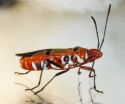(Press-News.org) SANTA CRUZ, CA--The remarkable diversity of California's plant life is largely the result of low extinction rates over the past 45 million years, according to a new study published in the journal Evolution. Although many new species have evolved in California, the rate at which plant lineages gave rise to new species has not been notably higher in California than elsewhere, researchers found.
Botanists have long recognized California as a biodiversity hotspot. With more than 5,500 native plant species, 40 percent of which are "endemic" (occurring nowhere else), California has more species and more endemic species than any other U.S. state, and is more species rich than most other places on Earth. The new findings highlight the importance of California as a refuge for plant species that might have gone extinct in other regions during the climatic shifts that occurred in the distant past.
"It seems that California has been an important refuge for plant lineages for a long time," said coauthor Kathleen Kay, assistant professor of ecology and evolutionary biology at the University of California, Santa Cruz. "These findings speak to the importance of protecting areas in California so that it can continue to be a refuge for biodiversity in the future."
First author Lesley Lancaster, now at Lund University in Sweden, became interested in collaborating with Kay after taking a course from her as a graduate student at UC Santa Cruz. She and Kay developed the project together after Lancaster received a postdoctoral fellowship to study plant evolution at the National Center for Ecological Analysis and Synthesis at UC Santa Barbara.
"Because California has so many unique and relatively young plant species, it was long assumed by biogeographers and naturalists that high speciation rates were the cause of California's biodiversity," Lancaster said. "It turns out that these species have not arisen at a particularly high rate in California compared to elsewhere. Instead, features of California's climate, topography, and latitude have preserved these species, allowing us to see them today, when they may have simply gone extinct if they had arisen elsewhere."
Lancaster and Kay are the first to tackle the question using modern methods of phylogenetic analysis. They studied 16 different plant lineages that are well represented both within and outside of California, and each lineage includes California endemic species. Using DNA sequence data to reconstruct the evolutionary "family trees" of these lineages, plus fossil records to calibrate the dates when different branches of each tree diverged, they were able to estimate historical rates of speciation, extinction, and migration across the California border.
Some of the study's key findings differ from long-standing ideas about the origins of California's extraordinary species richness that were set forth in a landmark study published in 1978, "Origin and relationships of the California flora," by Peter Raven and Daniel Axelrod. That classic work, which was based on analyses of fossil data and current distributions of plants, emphasized high speciation rates as an important contributor to high plant biodiversity in California.
Raven and Axelrod also hypothesized that the onset of the wet-winter, dry-summer Mediterranean climate in California 3 to 5 million years ago was a key factor that promoted high rates of speciation and led to the species richness that now characterizes California's flora. All the regions of the world with a Mediterranean climate (California, the cape of Africa, Southwestern Australia, the west coast of Chile, and around the Mediterranean sea) are currently plant biodiversity hotspots, and California does have a large number of relatively young species.
Lancaster and Kay's study, however, indicates that the onset of the Mediterranean climate did not affect speciation rates in California in most lineages. "Instead, low extinction rates over longer periods of time are responsible for species richness in California, and possibly in other Mediterranean regions as well," Lancaster said. "All of these regions share characteristics that predate the onset of the Mediterranean climate and that may have favored species persistence in each of these localities."
According to Kay, California's topographical diversity probably has played a critical role in preserving species richness. "People have talked about the topography fostering speciation, and it does play a role in that, but it plays a bigger role in preventing extinction by creating different niches and allowing lots of species to coexist," Kay said. "Topography also provides refuges, and the mountains are particularly important in preventing extinctions during times of climate change."
In a changing climate, species living on mountains can stay in the same temperature regime by shifting their elevation, moving relatively short distances compared to species on flat land that would have to shift their latitude by hundreds of miles to stay in the same temperature range. California's mountains are also important for their influence on precipitation, capturing the moisture in air masses coming off the Pacific Ocean, Kay said.
The new study did support several of Raven and Axelrod's conclusions. For example, they had predicted that cold-adapted lineages would have lower rates of speciation in California than warm-adapted lineages, which Lancaster and Kay confirmed. They also proposed that the onset of the Mediterranean climate facilitated the immigration of desert-adapted plants. Lancaster and Kay found that desert-adapted plants colonized California more recently than other lineages, arriving on average around 5 to 6 million years ago, in comparison to an average of around 17 million years ago for non-desert lineages.
"We just don't have a lot of evidence that the Mediterranean climate spurred speciation," Kay said. "Our work shows that the causes of the diversity we see now are more ancient than the Mediterranean climate itself."
In addition to topography, important features of California and other Mediterranean climate regions are their latitude and their location on the west coast of a continent, Lancaster said. Latitude is important because it allowed these regions to avoid glaciation during periods when global temperatures were cold and northern latitudes were covered in ice. During periods of global warmth, being situated where easterly air currents bring moisture onto the land from the ocean has kept these regions from becoming deserts.
"These regions are likely diverse because they are some of the only non-tropical regions to have been able to avoid historical periods of either desertification or glaciation," Lancaster said.
###
The NCEAS, where Lancaster worked on this study as a postdoctoral fellow, is funded by the National Science Foundation (grant #EF-0553768), UC Santa Barbara, and the State of California.
Low extinction rates made California a refuge for diverse plant species
Study attributes California's status as a plant biodiversity hotspot to low rates of extinction, rather than high rates of speciation
2013-01-09
ELSE PRESS RELEASES FROM THIS DATE:
NTU study looks at national attitudes towards homosexuals
2013-01-09
Singapore, 9 January 2013
Attitudes of Singaporeans and permanent residents toward gays and lesbians although sharply polarised and predominantly negative, have shifted slightly over a five-year span to become a little more favourable. This was found by a research team from the Wee Kim Wee School of Communication and Information at Nanyang Technological University (NTU).
A nationally representative survey found that people with higher levels of education and freethinkers tend to have more positive attitudes. Those who had higher interpersonal contact with gay men ...
How the brain stays receptive
2013-01-09
The channel protein Pannexin1 keeps nerve cells flexible and thus the brain receptive for new knowledge. Together with colleagues from Canada and the U.S., researchers at the Ruhr-Universität Bochum led by the junior professor Dr. Nora Prochnow from the Department of Molecular Brain Research describe these results in PLoS ONE. In the study, mice comprising no Pannexin1 in memory-related brain structures displayed symptoms similar to autism. Their nerve cells lacked synaptic plasticity, i.e. the ability to form new synaptic contacts or give up old contacts based on the level ...
Researchers reveal most effective treatment for common kidney disorder
2013-01-09
The results of a pioneering UK-wide clinical trial that compared treatments for patients with a common type of kidney disease has found one to be significantly more effective. The results of the study, published online in The Lancet today [9 Jan], will be recommended to clinicians worldwide as the most effective approach to treating the condition.
The Medical Research Council-funded study, led by researchers from the University of Bristol's Academic Renal Unit based in Southmead Hospital, compared three treatment approaches in a type of kidney disorder known as 'membranous ...
New study identifies significance of co-infection in disease control
2013-01-09
The new study analyses data from school aged children in Tanzania infected with the most common forms of worms. It was found that infection by one parasitic species actually changes the risk of catching another, over and above other risk factors.
The study is the first to look at the significance of infection with one disease as a risk for further infections (i.e. co-infection). The findings could help us better understand the importance of co-infection as a risk, and could help inform disease control strategies.
Traditionally, co-infection, where the person or ...
The Teotihuacans exhumed their dead and dignified them with make-up
2013-01-09
In collaboration with the National University of Mexico, a team of Spanish researchers has analysed for the first time remains of cosmetics in the graves of prehispanic civilisations on the American continent. In the case of the Teotihuacans, these cosmetics were used as part of the after-death ritual to honour their city's most important people.
A research team from the Polytechnic University of Valencia and the University of Valencia has studied various funerary samples found in urns in the Teotihuacan archaeological site (Mexico) that date from between 200 and 500 ...
R U eating healthy 2day?
2013-01-09
AUDIO:
Melanie Hingle, Ph.D., MPH, RD, University of Arizona, discusses the effectiveness of using text messaging to engage adolescents in ‘‘conversations’’ about health using a familiar communication method -- that is...
Click here for more information.
Philadelphia, PA, January 9, 2013 – According to the Nielsen consumer research group, teens receive an average of 3,417 text messages per month (that's 114 texts per day!). Couple this with CDC's report that high school students' ...
Making whole wheat bread taste and smell more appetizing
2013-01-09
The key to giving whole wheat bread a more appetizing aroma and taste may lie in controlling the amounts of a single chemical compound that appears in the bread, which nutritionists regard as more healthful than its refined white counterpart. That's the finding of a new study in ACS' Journal of Agricultural and Food Chemistry, which opens the door to making whole wheat bakery products more appealing to millions of people.
Devin G. Peterson and colleagues explain that whole wheat flour includes all three layers of the grain — bran, germ and endosperm — while refined flour ...
Chemical modules that mimic predator-prey and other behaviors
2013-01-09
Scientists are reporting development of chemical modules that can reproduce, on an "unprecedented" molecular level, changes and interactions that occur in natural populations of plants and animals, including those of hunting and being hunted for food, conducting mutually beneficial relationships and competing for resources. The report on these new "predator-prey biochemical oscillators," which could become building blocks for molecular machines and computers, appears in ACS Nano.
Yannick Rondelez and Teruo Fujii explain that just as plants and animals interact in complex ...
Bugs need symbiotic bacteria to exploit plant seeds
2013-01-09
This press release is available in German.
Aggregations of the red and black colored firebugs are ubiquitous under linden trees in Central Europe, where the bugs can reach astounding population densities. While these insects have no impact on humans, their African, Asian, and American relatives, the cotton stainers, are serious agricultural pests of cotton and other Malvaceous plants. Researchers at the Max Planck Institute for Chemical Ecology in Jena, Germany, recently discovered that these bugs need bacterial symbionts to survive on cotton seeds as their sole food source. ...
Used coffee grounds are a rich source of healthful antioxidants
2013-01-09
To plant food, insect repellant and other homespun uses for spent coffee grounds, scientists are adding an application that could make the gunk left over from brewing coffee a valuable resource for production of dietary supplements. Their new report in ACS' Journal of Agricultural and Food Chemistry concludes that used coffee grounds are a rich source of healthful antioxidant substances.
Maria-Paz de Peña and colleagues explain that people around the world drink millions of cups of coffee every day, generating about 20 million tons of used grounds annually. Although some ...
LAST 30 PRESS RELEASES:
Manta rays create mobile ecosystems, study finds
Study: Mixed results in using lipoic acid to treat progressive multiple sclerosis
Norbert Holtkamp appointed director of Fermi National Accelerator Laboratory
New agentic AI platform accelerates advanced optics design
Biologists discover neurons use physical signals — not electricity — to stabilize communication
Researchers discover that a hormone can access the brain by hitchhiking
University of Oklahoma researcher awarded funding to pursue AI-powered material design
Exploring how the visual system recovers following injury
Support for parents with infants at pediatric check-ups leads to better reading and math skills in elementary school
Kids’ behavioral health is a growing share of family health costs
Day & night: Cancer disrupts the brain’s natural rhythm
COVID-19 vaccination significantly reduces risk to pregnant women and baby
The role of vaccination in maternal and perinatal outcomes associated with COVID-19 in pregnancy
Mayo Clinic smartwatch system helps parents shorten and defuse children's severe tantrums early
Behavioral health spending spikes to 40% of all children’s health expenditures, nearly doubling in a decade
Digital cognitive behavioral treatment for generalized anxiety disorder
Expenditures for pediatric behavioral health care over time and estimated family financial burden
Air conditioning in nursing homes and mortality during extreme heat
The Alps to lose a record number of glaciers in the next decade
What makes a good proton conductor?
New science reporting guide published for journalists in Bulgaria
New international study reveals major survival gaps among children with cancer
New science reporting guide published for journalists in Turkey
Scientists develop a smarter mRNA therapy that knows which cells to target
Neuroanatomy-informed brain–machine hybrid intelligence for robust acoustic target detection
Eight SwRI hydrogen projects funded by ENERGYWERX
The Lundquist Institute and its start-up company Vitalex Biosciences Announces Strategic Advancement of Second-Generation fungal Vaccine VXV-01 through Phase 1 Trials under $40 Million Competitive Con
Fine particles in pollution are associated with early signs of autoimmune disease
Review article | Towards a Global Ground-Based Earth Observatory (GGBEO): Leveraging existing systems and networks
Penn and UMich create world’s smallest programmable, autonomous robots
[Press-News.org] Low extinction rates made California a refuge for diverse plant speciesStudy attributes California's status as a plant biodiversity hotspot to low rates of extinction, rather than high rates of speciation


